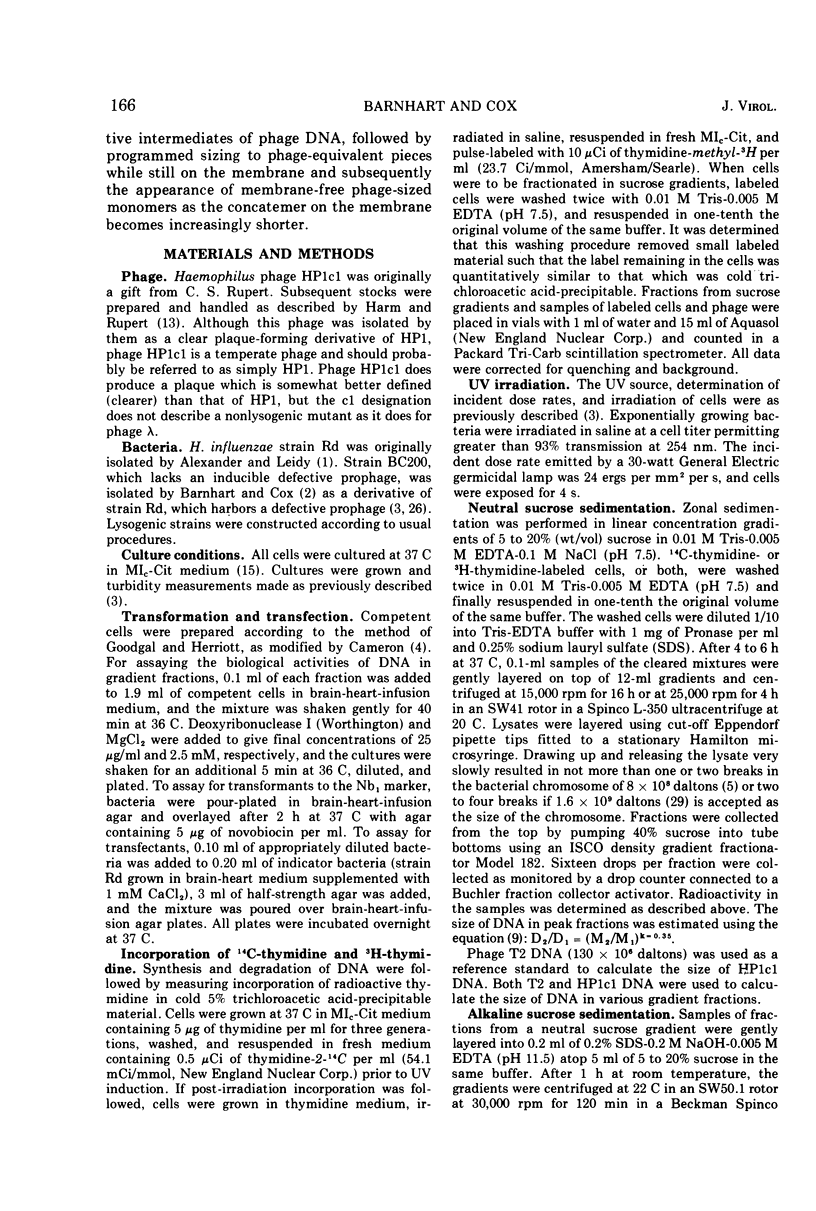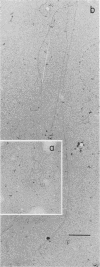Abstract
DNA synthesis during transition from the lysogenic state to the lytic cycle and throughout the latter has been studied in Haemophilus influenzae BC200 (HP1c1). Following exposure to ultraviolet light, there is a 30-min delay in DNA synthesis after which there is a rapidly increasing rate of phage DNA synthesis. The phage genome is replicated without extensive utilization of segments or of breakdown products of the bacterial chromosome. The mode of phage DNA replication was investigated by zonal sedimentation of labeled DNA in 5 to 20% neutral and alkaline sucrose gradients. Tritiated thymidine, incorporated during a 2-min pulse given at 38 min, chases rapidly into DNA, sedimenting like linear DNA of approximately 2 × 108 daltons, and then, at the expense of label in this peak, chases into slower-sedimenting phage DNA (2 × 107 daltons). The fast-sedimenting, rapidly labeled DNA satisfies certain criteria for being a concatenated replicative intermediate. Observations in the electron microscope revealed linear concatemers in the faster-sedimenting material and circular phage-sized DNA in the slower-sedimenting DNA. When induced cells are gently lysed with lysozyme and Brij 58 to maintain DNA-membrane associations and sedimented in neutral sucrose over a cesium chloride shelf, the concatemer is found with the cell-membrane-wall complex. Membrane-associated label chases to membrane-free material sedimenting like deproteinized HP1c1 DNA. When membrane-associated DNA from the cesium chloride shelf is deproteinized and resedimented in neutral sucrose, the sedimentation profile reveals that sedimentation rates of labeled DNA from this complex are indicative of sizes ranging from 2 × 108 daltons down to phage-sized pieces of 2 to 3 × 107 daltons. A model is presented which places HP1c1-DNA replication on the cell membrane where a concatemer of phage DNA is synthesized and subsequently degraded to phage-equivalent DNA. Phage-equivalent DNA is then either released from the membrane for packaging or is packaged while still membrane associated. Thus, the cell membrane is not only the site of DNA replication during which phage DNA is synthesized in multiple phage-equivalent concatemers but it is also the site at which these concatemers are selectively reduced to phage-sized pieces.
Full text
PDF











Images in this article
Selected References
These references are in PubMed. This may not be the complete list of references from this article.
- ALEXANDER H. E., LEIDY G. Induction of streptomycin resistance in sensitive Hemophilus influenzae by extracts containing desoxyribonucleic acid from resistant Hemophilus influenzae. J Exp Med. 1953 Jan;97(1):17–31. doi: 10.1084/jem.97.1.17. [DOI] [PMC free article] [PubMed] [Google Scholar]
- BARNHART B. J., HERRIOTT R. M. PENETRATION OF DEOXYRIBONUCLEIC ACID INTO HEMOPHILUS INFLUENZAE. Biochim Biophys Acta. 1963 Sep 17;76:25–39. [PubMed] [Google Scholar]
- BERNS K. I., THOMAS C. A., Jr ISOLATION OF HIGH MOLECULAR WEIGHT DNA FROM HEMOPHILUS INFLUENZAE. J Mol Biol. 1965 Mar;11:476–490. doi: 10.1016/s0022-2836(65)80004-3. [DOI] [PubMed] [Google Scholar]
- BURGI E., HERSHEY A. D. Sedimentation rate as a measure of molecular weight of DNA. Biophys J. 1963 Jul;3:309–321. doi: 10.1016/s0006-3495(63)86823-x. [DOI] [PMC free article] [PubMed] [Google Scholar]
- Barnhart B. J., Cox S. H. Radiation-sensitive and radiation-resistant mutants of Haemophilus influenzae. J Bacteriol. 1968 Jul;96(1):280–282. doi: 10.1128/jb.96.1.280-282.1968. [DOI] [PMC free article] [PubMed] [Google Scholar]
- Barnhart D. J., Cox S. H. Recovery of Haemophilus influenzae from ultraviolet and x-ray damage. Photochem Photobiol. 1970 Mar;11(3):147–162. doi: 10.1111/j.1751-1097.1970.tb05983.x. [DOI] [PubMed] [Google Scholar]
- Boling M. E., Setlow J. K., Allison D. P. Bacteriophage of Haemophilus influenzae. I. Differences between infection by whole phage, extracted phage DNA and prophage DNA extracted from lysogenic cells. J Mol Biol. 1972 Feb 14;63(3):335–348. doi: 10.1016/0022-2836(72)90431-7. [DOI] [PubMed] [Google Scholar]
- Botstein D., Levine M. Intermediates in the synthesis of phage P22 DNA. Cold Spring Harb Symp Quant Biol. 1968;33:659–667. doi: 10.1101/sqb.1968.033.01.075. [DOI] [PubMed] [Google Scholar]
- Botstein D. Synthesis and maturation of phage P22 DNA. I. Identification of intermediates. J Mol Biol. 1968 Jun 28;34(3):621–641. doi: 10.1016/0022-2836(68)90185-x. [DOI] [PubMed] [Google Scholar]
- Frankel F. R. Evidence for long DNA strands in the replicating pool after T4 infection. Proc Natl Acad Sci U S A. 1968 Jan;59(1):131–138. doi: 10.1073/pnas.59.1.131. [DOI] [PMC free article] [PubMed] [Google Scholar]
- Gillis M., De Ley J., De Cleene M. The determination of molecular weight of bacterial genome DNA from renaturation rates. Eur J Biochem. 1970 Jan;12(1):143–153. doi: 10.1111/j.1432-1033.1970.tb00831.x. [DOI] [PubMed] [Google Scholar]
- HARM W., RUPERT C. S. INFECTION OF TRANSFORMABLE CELLS OF HAEMOPHILUS INFLUENZAE BY BACTERIOPHAGE AND BACTERIOPHAGE DNA. Z Vererbungsl. 1963 Dec 30;94:336–348. doi: 10.1007/BF00897593. [DOI] [PubMed] [Google Scholar]
- HENDLER R. W., BANFIELD W. G., TANI J., KUFFEL ON THE CYTOLOGICAL UNIT FOR PROTEIN SYNTHESIS IN VIVO IN E. COLI. III. ELECTRON MICROSCOPIC AND ULTRACENTRIFUGAL EXAMINATION OF INTACT CELLS AND FRACTIONS. Biochim Biophys Acta. 1964 Feb 17;80:307–314. [PubMed] [Google Scholar]
- Hallick L., Boyce R. P., Echols H. Membrane association by bacteriophage lambda-DNA: possible direct role of regulator gene N. Nature. 1969 Sep 20;223(5212):1239–1242. doi: 10.1038/2231239a0. [DOI] [PubMed] [Google Scholar]
- Herriott R. M., Meyer E. Y., Vogt M., Modan M. Defined medium for growth of Haemophilus influenzae. J Bacteriol. 1970 Feb;101(2):513–516. doi: 10.1128/jb.101.2.513-516.1970. [DOI] [PMC free article] [PubMed] [Google Scholar]
- Joyner A., Isaacs L. N., Echols H., Sly W. S. DNA replication and messenger RNA production after induction of wild-type lambda bacteriophage and lambda mutants. J Mol Biol. 1966 Aug;19(1):174–186. doi: 10.1016/s0022-2836(66)80059-1. [DOI] [PubMed] [Google Scholar]
- Kantor G. J. Anomalies in the sedimentation of deoxyribonucleic acid from Haemophilus influenzae in alkaline sucrose gradients. J Bacteriol. 1972 Dec;112(3):1264–1269. doi: 10.1128/jb.112.3.1264-1269.1972. [DOI] [PMC free article] [PubMed] [Google Scholar]
- Lipton A., Weissbach A. The formation of circular DNA after lysogenic induction. Biochem Biophys Res Commun. 1966 May 25;23(4):436–441. doi: 10.1016/0006-291x(66)90746-7. [DOI] [PubMed] [Google Scholar]
- McGrath R. A., Williams R. W. Reconstruction in vivo of irradiated Escherichia coli deoxyribonucleic acid; the rejoining of broken pieces. Nature. 1966 Oct 29;212(5061):534–535. doi: 10.1038/212534a0. [DOI] [PubMed] [Google Scholar]
- Moore L. D., Kocun F. J., Umbreit W. W. Cell-free protein synthesis: effects of age and state of ribosomal aggregation. Science. 1966 Dec 9;154(3754):1350–1353. doi: 10.1126/science.154.3754.1350. [DOI] [PubMed] [Google Scholar]
- Rupp W. D., Howard-Flanders P. Discontinuities in the DNA synthesized in an excision-defective strain of Escherichia coli following ultraviolet irradiation. J Mol Biol. 1968 Jan 28;31(2):291–304. doi: 10.1016/0022-2836(68)90445-2. [DOI] [PubMed] [Google Scholar]
- SENO T., MELECHEN N. E. MACROMOLECULAR SYNTHESES IN THE INITIATION OF BACTERIOPHAGE P1 INDUCTION. J Mol Biol. 1964 Aug;9:340–351. doi: 10.1016/s0022-2836(64)80211-4. [DOI] [PubMed] [Google Scholar]
- Salzman L. A., Weissbach A. Formation of intermediates in the replication of phage lambda DNA. J Mol Biol. 1967 Aug 28;28(1):53–70. doi: 10.1016/s0022-2836(67)80077-9. [DOI] [PubMed] [Google Scholar]
- Smith K. C., Meun D. H. Repair of radiation-induced damage in Escherichia coli. I. Effect of rec mutations on post-replication repair of damage due to ultraviolet radiation. J Mol Biol. 1970 Aug;51(3):459–472. doi: 10.1016/0022-2836(70)90001-x. [DOI] [PubMed] [Google Scholar]
- Stonington O. G., Pettijohn D. E. The folded genome of Escherichia coli isolated in a protein-DNA-RNA complex. Proc Natl Acad Sci U S A. 1971 Jan;68(1):6–9. doi: 10.1073/pnas.68.1.6. [DOI] [PMC free article] [PubMed] [Google Scholar]
- Weissbach A., Bartl P., Salzman L. A. The structure of replicative lambda DNA--electron microscope studies. Cold Spring Harb Symp Quant Biol. 1968;33:525–531. doi: 10.1101/sqb.1968.033.01.060. [DOI] [PubMed] [Google Scholar]



